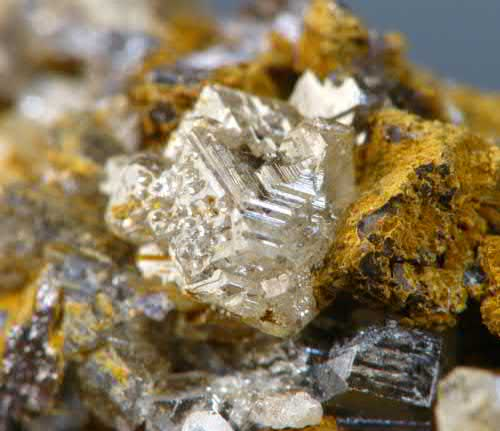ヨウ化銅 化学特性,用途語,生産方法
外観
ほとんど白色〜うすい褐色又はうすい灰色, 粉末又は塊
性質
ヨウ化銅は、融点/凝固点は605℃、沸点又は初留点及び沸騰範囲は1,336℃、密度は5.62g/cm2、常温で固体です。または硝酸・ の混液に徐々に溶け、水やにはほとんど溶けないという性質をもっています。
溶解性
水に不溶 (8×10^(-4)g/100ml水, 18℃), エタノールに不溶。硝酸及び硝酸と塩酸の混液に徐々に溶け、水及びエタノールにほとんど溶けないアンモニア水、ハロゲン化アルカリ溶液には錯イオンをつくって溶ける。
解説
CuI(190.45).硫酸銅水溶液に二酸化硫黄を通じつつヨウ化カリウム水溶液を加えると,白色の粉末状沈殿として得られる.立方晶系,せん亜鉛鉱型構造.ヨウ化銅は,密度5.63 g cm-3.融点605 ℃,沸点1290 ℃.水に難溶.アンモニア水,ヨウ化カリウムおよびシアン化カリウム水溶液には錯イオンをつくって溶ける.有機反応の触媒,難燃剤,樹脂改質剤として用いられるほか,超イオン伝導体として注目されており,導電剤,固体電解質の成分などとしても用いられる.[CAS 7681-65-4]
森北出版「化学辞典(第2版)
製造法
ヨウ化銅の製造法
ヨウ化銅は、ヨウ化ナトリウムまたはの水溶液に、など水溶性の銅イオンを加えることで、実験室レベルで合成できます。また、ヨウ化水素酸中でヨウ素とを加熱することでも生成します。
ヨウ化銅は極めて水に溶けにくいですが、NaIやKI存在下ではイオンとなって溶解します。溶液を水で薄めるとヨウ化銅が析出するため、無色で純度の高いヨウ化銅を得るための精製法として用いることができます。
用途
有機合成試薬や人工降雨剤など幅広い分野で用いられている。
構造
ヨウ化銅は、温度によって様々な構造をとります。390℃以下では閃亜鉛鉱型構造 (γ-CuI) 、390~440℃ではウルツ鉱型構造 (β-CuI) 、440℃以上では塩化ナトリウム型構造 (α-CuI) となります。
化学的特性
Cuprous Iodide, Cu2O, cubic white crystals, practically insoluble in H2O or alcohol, soluble in NH4OH, potassium iodide, or potassium cyanide. Used in Sandmeyer’s reaction to synthesize aryl chlorides.
使用
Cuprous iodide is used in the preparation of alkynyl imines, which are crucial intermediates for the synthesis of pyrroles and pyrrole heterocycles. It plays a role in the synthesis of BTBT derivatives, specifically benzothieno[3,2-b]benzothiophene, which are semiconductors used in transistors. Beyond its synthetic utility, copper (I) iodide serves as a catalyst for N-arylation of amines and amino acids, facilitating organic reactions. It also has practical applications as an ice-nucleating chemical, a coating in cathode-ray tubes, and as a source of iodine in animal feeds.
一般的な説明
Odorless tan or off-white solid. Sinks in water.

Marshite, CuI, octahedral crystals to 4 mm
反応プロフィール
Cuprous iodide has weak oxidizing or reducing powers. Redox reactions can however still occur. The majority of compounds in this class are slightly soluble or insoluble in water. If soluble in water, then the solutions are usually neither strongly acidic nor strongly basic. These compounds are not water-reactive.
危険性
Toxic.
健康ハザード
Inhalation causes irritation of nose and throat. Ingestion of copper salts produces violent vomiting and purging, intense pain, collapse, coma, convulsions, and paralysis. Contact with eyes or skin causes irritation.
火災危険
Special Hazards of Combustion Products: Irritating hydrogen iodide or iodine vapors may form in fire.
使用用途
ヨウ化銅は、電子材料や触媒、樹脂改質剤、医薬といった多方面の原料として使用されています。
1. 電子材料
ヨウ化銅は、電子材料の分野では無機P型半導体の材料として知られています。
半導体には、電子が動くN型半導体とホール (電子のぬけた穴) が動くP型半導体の2種類があります。この中でP型半導体は、実際には電子が移動することでホールがあたかも動くとした半導体で、その中で有機と無機の半導体が製作されています。ヨウ化銅は、このうちの無機P型半導体の材料として優れた特性をもつため使用されています。
2. 有機合成試薬
ヨウ化銅は、有機合成化学分野では触媒やヨウ素化試薬として用いられます。
薗頭カップリング、ウルマン反応などをはじめとするクロスカップリング反応において触媒、あるいは助触媒として働きます。また、と同様に、臭化アリールからヨウ化アリールへの変換反応にも用いることができます。ヨウ化アリールは、各種カップリング反応において臭化アリールより高い反応性を示すことから、この変換は産業的にも重要です。
法規情報
ヨウ化銅は国内法規上、毒物及び劇物取締法で「劇物 包装等級3」、労働安全衛生法で「名称等を表示すべき危険物及び有害物」、「名称等を通知すべき危険物及び有害物No. 379, 606」に指定されています。さらにヨウ化銅は、水質汚濁防止法で「指定物質」、大気汚染防止法でも「有害大気汚染物質」に指定されており、注意が必要です。
純化方法
Cuprous iodide can be freshly prepared by dissolving an appropriate quantity of CuI in boiling saturated aqueous NaI over 30minutes. Pure CuI is obtained by cooling and diluting the solution with water, followed by filtering and washing sequentially with H2O, EtOH, EtOAc, Et2O and pentane, then drying in vacuo for 24hours [Dieter, J Am Chem Soc 107 4679 1985]. Alternatively wash it with H2O, then EtOH and finally with Et2O containing a little iodine. Traces of H2O are best removed first by heating at 110o and then at 400o. Exess of I2 is removed completely at 400o. It dissolves in Et2O if an amine is present to form the amine complex. On heating it becomes red, then black, but changes to white on cooling. It is sparingly soluble in H2O or alkali iodide solutions but readily soluble in NH3 (which absorbs CO) and in cyanide or thiosulfate solutions. [Glemser & Sauer in Handbook of Preparative Inorganic Chemistry (Ed Brauer) Academic Press Vol II p 1007 1965, Bawn & Ledwith Chem Ind (London) 1180 1957.]
ヨウ化銅 上流と下流の製品情報
原材料
準備製品